Wind Cave National Park gets its name for its large, underground cavern and maze of passageways. What many people may not be aware of is that above ground, this park is home to one of the largest prairies in the USA, and with that comes amazing wildlife viewing opportunities. In this guide, we cover the best things to do in Wind Cave National Park, both below and above ground.
Interesting Facts about Wind Cave National Park
As of 2023, Wind Cave is the seventh largest cave system in the world and the third longest cave in the United States (Mammoth Cave is #1 and nearby Jewel Cave is #2).
What makes Wind Cave even more unique is its extensive amount of boxwork. Boxwork is made of calcite, which has formed in thin blades, creating a box-like or honeycomb pattern. The surrounding bedrock and limestone slowly eroded away, revealing these veins of calcite.
Wind Cave contains approximately 95% of the world’s discovered boxwork.
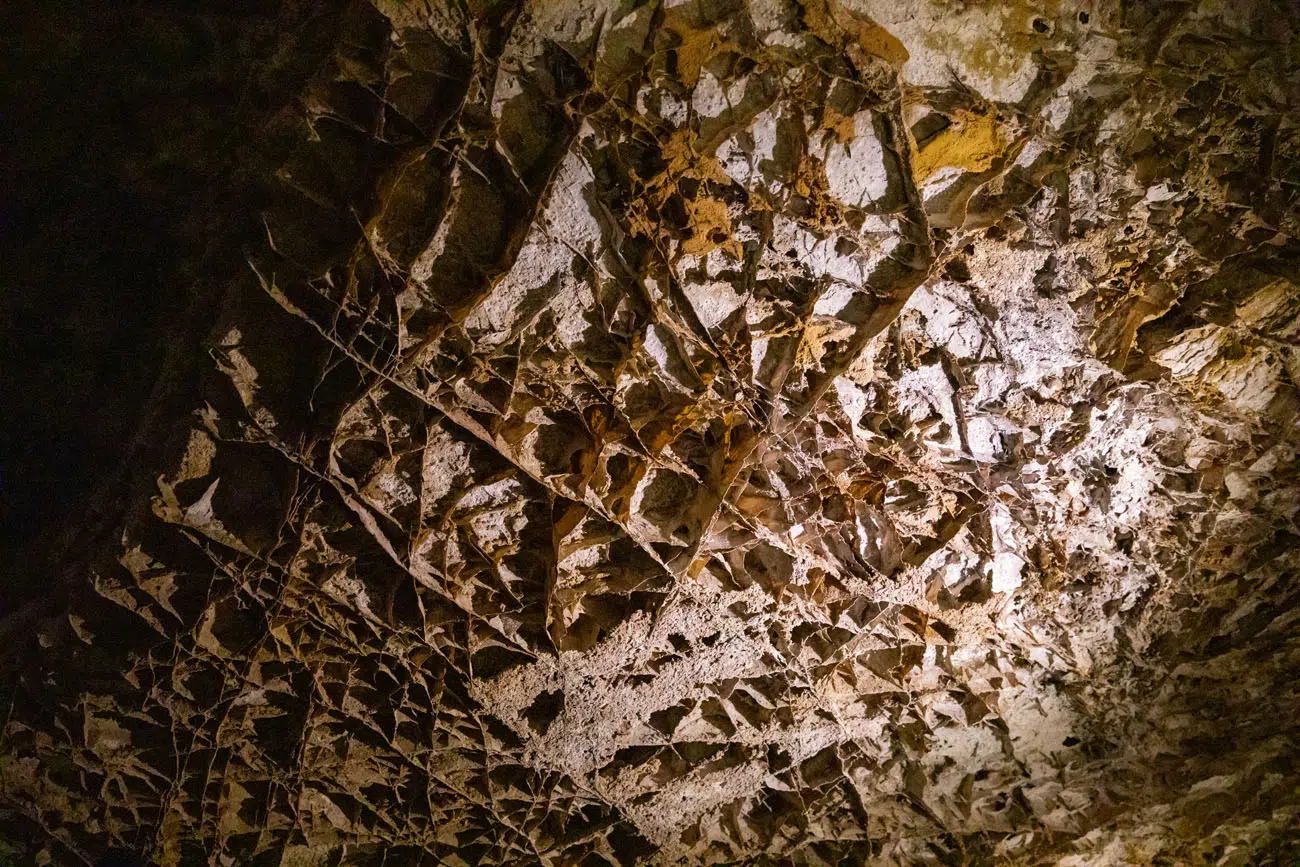
Boxwork
Above ground, Wind Cave National Park is home to one of the largest mixed-grass prairies in the USA. Bison, elk, prairie dogs, pronghorns, and coyotes can all be seen here. In fact, this is one of the best national parks in the United States for wildlife viewing, rivaling Yellowstone in some respects.
Wind Cave gets its name from the Lakota, the indigenous people of the Black Hills. They spoke of a spirit lodge under the ground, a sacred site from where they lived before the creation of the world. In modern Lakota, this place is known as Maka Oniye, or “breathing earth,” since wind blows from the entrance into the cave. You can read the Lakota Emergence story on the National Park Service website.
Wind Cave was one of the first national parks to be established. It officially became a national park January 3, 1903, making it the seventh US national park. It was also the first cave to be designated as a national park.
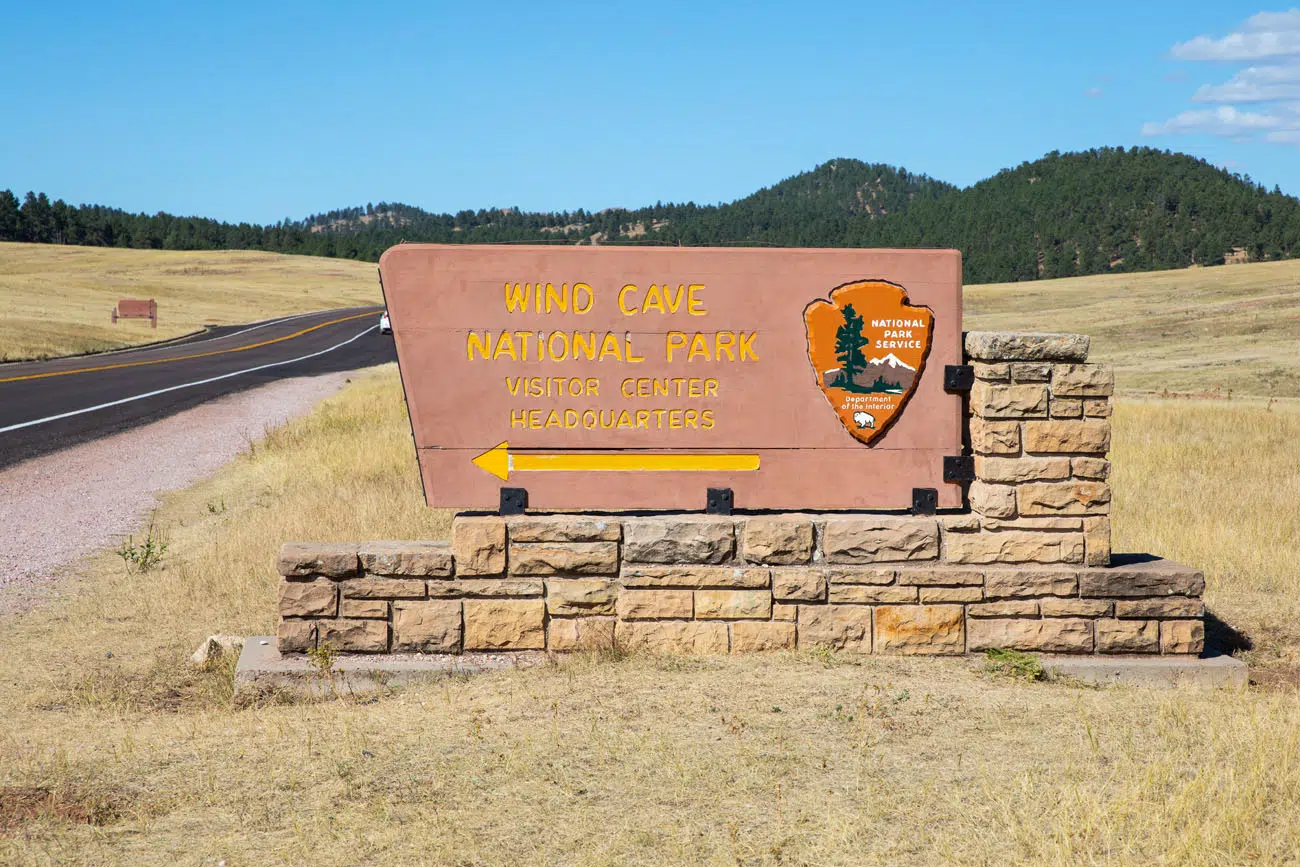
Geography and Map of Wind Cave National Park
Wind Cave National Park is located near the Black Hills of South Dakota. It sits just to the south of Custer State Park.
At 34,000 acres, this is one of the smaller US national parks. Two main roads (SD-87 and US-385) travel along the west side of the park. From here, several hiking trails lead into the grasslands. As you drive down this road, you are almost guaranteed to see bison. There are also two gravel roads on the east side of the park (NPS 5 and NPS 6) that visitors can drive.
The visitor center forms the main hub of the park. This is where most cave tours start and where you will purchase your cave tour tickets.
Below is a map of Wind Cave National Park from the National Park Service.

Best Things to Do in Wind Cave National Park
The list of things to do in Wind Cave National Park is relatively short. Taking a cave tour tops the list but there are several above ground activities that are well worth your time.
#1 Take a Cave Tour
Touring the cave is the best thing to do in Wind Cave National Park. These tours last just over an hour and range from easy to strenuous.
All tours are ranger-guided. You cannot visit the cave on your own or do a self-guided tour.
Garden of Eden Tour
Time: 1 hour | Difficulty: Easy | Stairs: 150 | Distance: 0.33 miles
Enter and exit the cave by elevator, making this the easiest tour on the list. This tour starts at the visitor center and along the way you get to see boxwork, popcorn, and flowstone formations. This is a good choice for those who don’t want to walk far, don’t want to walk a lot of steps, or are short on time.
Natural Entrance Tour
Time: 1.25 hours | Difficulty: Moderate | Stairs: 300 | Distance: 0.66 miles
This is the most popular tour and the tour that we took. On this tour, you will see the natural entrance into the cave and then enter the cave via a manmade tunnel.
According to several park rangers we spoke to, this route is one of the best places to see boxwork, since it is so extensive in this part of the cave.
You will walk down a lot of stairs and the path you walk is paved and wet. There are several passageways but if you have claustrophobia, you should be OK. These passages are short and not too narrow.
To get back to the surface, you will ride an elevator to the visitor center.

Natural Entrance Tour
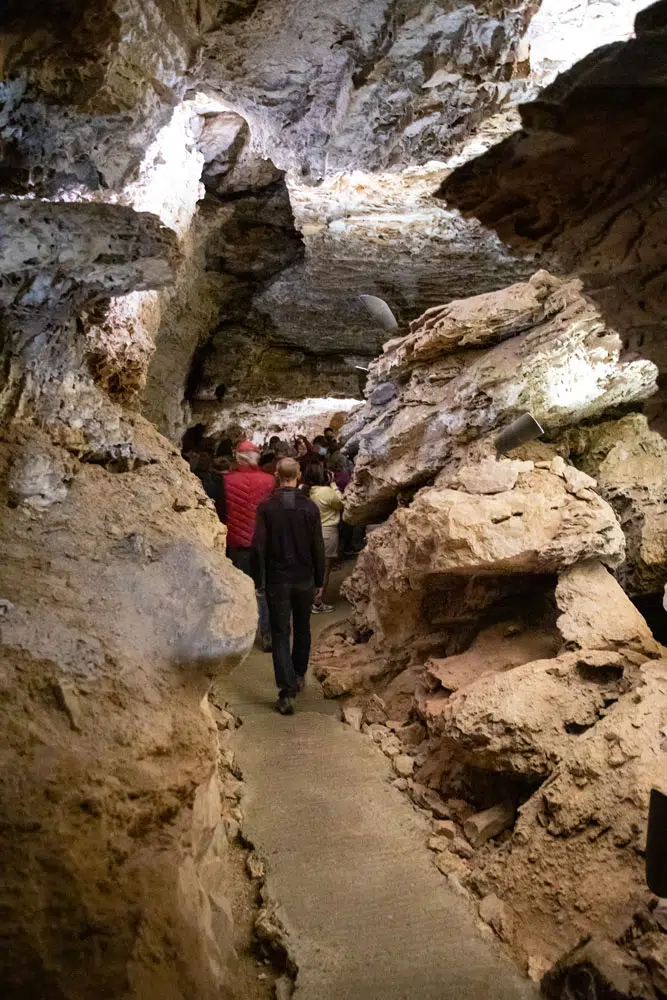
Passageway on the Natural Entrance Tour

One of many staircases on the Natural Entrance Tour. Most of the time, you will walk down the stairs. An elevator at the end of the tour takes you back to the above ground world of Wind Cave National Park.
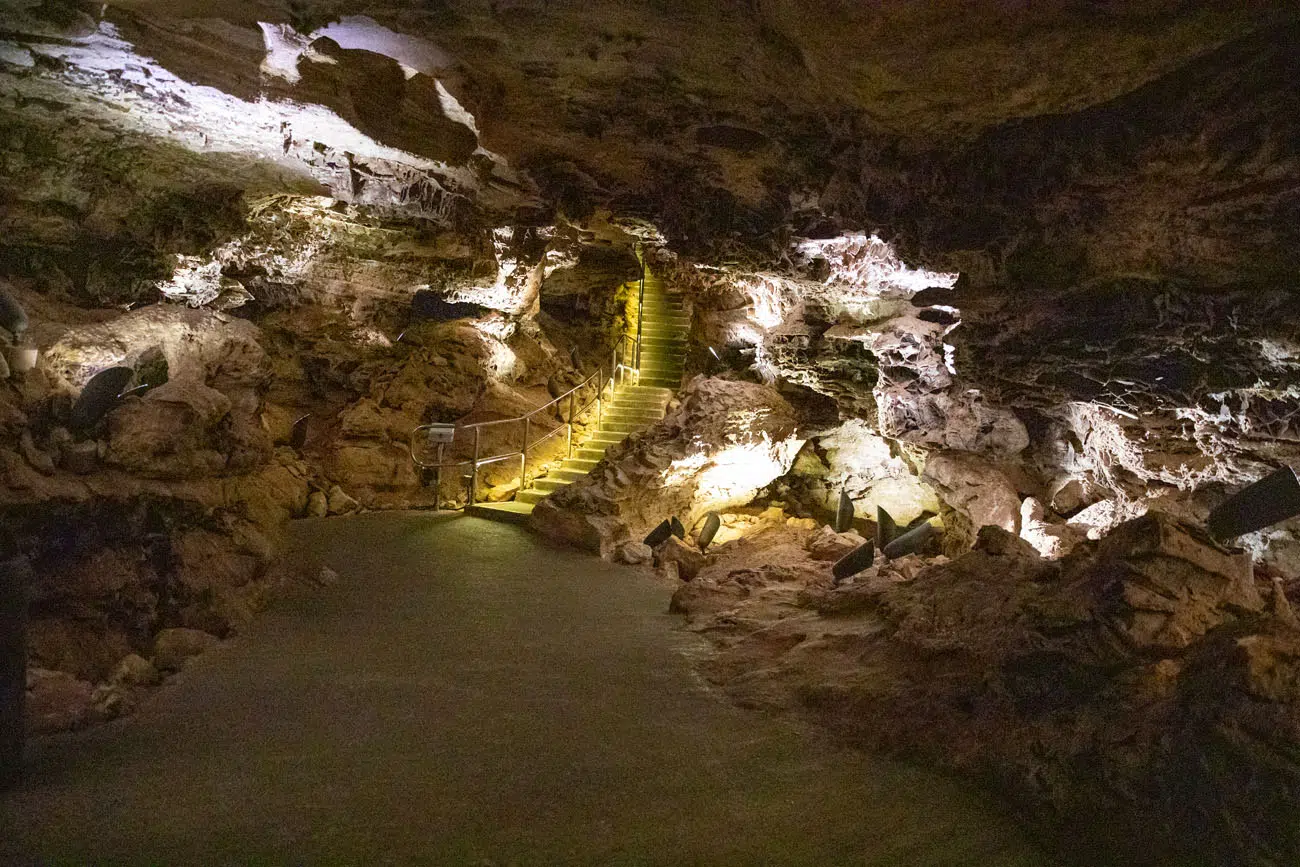
Cavern on the Natural Entrance Tour
Fairgrounds Tour
Time: 1.5 hours | Difficulty: Strenuous | Stairs: 450 | Distance: 0.66 miles
This is the most strenuous of the three tour options. On this tour, you will explore the middle and upper level of the cave and get to see boxwork, frostwork, and popcorn. There is one long flight of 89 stairs to climb. To get back up to the surface, you will take the elevator.
Additional Tours
There are two other tour options that only run in the summer.
The Wild Cave Tour is 4 hours long and on this tour, you get a lesson on caving and will crawl through tight passageways. Participants must be 16 years or older.
The Candlelight Tour is 2 hours long. Explore a more remote area of the cave by candlelight. Group size is smaller on this tour.
Choosing the Best Tour
We spoke to several park rangers about which tour they recommended. It was unanimous that the Natural Entrance Tour is the best tour to take. You can see the natural entrance of the cave and the extensive boxwork. Plus, it is a little bit shorter than the Fairgrounds Tour.
We took the Natural Entrance Tour and enjoyed it. However, Wind Cave does not have the same “wow factor” as Carlsbad Caverns (with its astounding number of stalactites and stalagmites) or Mammoth Cave (with its sheer size).
The best part of Wind Cave National Park, in my opinion, is not the cave. It’s what you can do above ground that makes this place great to visit. We will get to that soon, but there are a few more things to tell you about the cave tours.
Purchasing Cave Tour Tickets
Tickets for each tour, with the exception of the Candelight and Wild Cave Tour, are sold online in advance. Roughly half of the tickets are held in reserve for same-day purchase.
We recommend purchasing your tickets in advance because they typically sell out. Reservations are made on recreation.gov and can be made 3 to 120 days before the date of the tour. The Candlelight and Wild Cave Tour are the two tours that cannot be reserved in advance (these must be made by phone 605-745-4600).
Learn more on the National Park Service website.
If you did not purchase your tickets in advance, try to get to the visitor center as early as possible, to purchase one of the same-day tour tickets. The visitor center is generally open from 8 am to 5 pm, but hours can vary by season. Before your visit, get updated hours on the National Park Service website.
The cave tour schedule varies by season. You can get the updated schedule here.
#2 Go on a Scenic Drive
Two main roads, SD-87 and US-385, travel through the west side of the park. Every time we have driven this road (we have visited Wind Cave multiple times over two different years) we see bison right along the road.

Bison in Wind Cave National Park near the visitor center.
There are several pull-outs where you can stop and take a photo. Do not approach the bison. They may not look like it, but they are fast and have been known to charge at people.
NPS 5 and NPS 6 are two gravel roads that travel through the east side of the park. They are well-maintained and suitable for standard vehicles. There is also a very good chance that you will see bison or other wildlife along these roads.
#3 See the Natural Entrance of Wind Cave
If you take the Natural Entrance tour, this will be included on the tour. However, if you choose a different cave tour, or skip the cave tours altogether, then you have the option to visit this on your own.

Natural entrance of Wind Cave
From the visitor center, walk the Prairie Vista Nature Trail. It takes just a minute or two to get to the natural entrance. This is the place where the cave “breathes.” The difference in barometric pressure between the cave and the outside world is what causes the wind.
Beyond the natural entrance, you can continue on the Prairie Vista Nature Trail, which forms a one-mile loop around the visitor center, with views of the prairie. Or, take your pick from the hiking trails below.
#4 Hike the Rankin Ridge Trail
Distance: 1 mile | Difficulty: Moderate | Total Ascent: 275 feet | Time: 30 to 60 minutes
This is a wonderful, short hike to do in Wind Cave National Park. This trail makes a loop around the top of Rankin Ridge and reaches its highest point at the Rankin Fire Tower. Along the way, you have 360° views of the area and on a clear day you can see Badlands National Park.

Rankin fire tower

View looking west from Rankin Ridge.

View looking east from Rankin Ridge.
Rankin Ridge Trail Elevation Profile
GETTING HERE: From SD-87, near the northern entrance into the park, take the unnamed access road to the Rankin Ridge Trail. There is parking right next to the trailhead.
#5 Lookout Point Trail and Centennial Trail Loop
Distance: 4.8-mile loop | Difficulty: Easy to moderate | Total Ascent: 550 feet | Time: 2 to 3 hours
This is our favorite experience in Wind Cave National Park.
This hike combines two trails, the Centennial Trail and the Lookout Point Trail, into one big loop.
On this hike, you will walk through fields of prairie grass and forests of ponderosa pine, past prairie dog towns, and most likely you will see a few bison, elk, or pronghorn.
When we did this, we spotted bison several times along the trail.

Prairie dog and bison in the distance.


Lookout Point Trail
The highlight was the Lookout Point Trail, where it was just Tim and I, lots of barking prairie dogs, and a large herd of bison off in the distance.
To be out here, away from other people, roads, and cars, was awesome. Here we were, alone, standing in the same field as these magnificent animals. After this experience, it now seems somewhat boring to spot bison from the car, whether in Yellowstone, Custer State Park, or Badlands National Park.
#6 Cold Brook Canyon
Distance: 2.7 miles out-and-back | Difficulty: Easy to moderate | Total Ascent: 250 feet | Time: 1 to 2 hours
After our wonderful Lookout Point hiking experience, we were eager to do another hike in the park. A park ranger recommended this one to us, since you also have a good chance to see bison or other wildlife.
Well, we weren’t so lucky this time. We saw zero wildlife along this trail. It’s an easy hike and the views are nice, but I only recommend doing this if you have already done a cave tour and the Lookout Point hike (the two best things to do in Wind Cave National Park).

Cold Canyon Trail
While in Wind Cave National Park, please practice the seven principles of Leave No Trace: plan ahead, stay on the trail, pack out what you bring to the hiking trail, properly dispose of waste, leave areas as you found them, minimize campfire impacts, be considerate of other hikers, and do not approach or feed wildlife.
How Much Time Do You Need in Wind Cave National Park?
For the best experience, plan on spending one day in Wind Cave National Park. This gives you plenty of time for a cave tour and to hike the Lookout Point Trail Loop and/or the Rankin Ridge Trail.
Here is a sample itinerary for the summer:
7:30 am: Get in line for cave tour tickets 30 minutes before the visitor center opens if you did not purchase them in advance (double check the visitor center hours because these can change seasonally)
8 am: Purchase your cave tour tickets for a tour time in the afternoon (if you did not purchase them in advance)
8:30 am: Hike the Lookout Point Trail and Centennial Trail Loop
11:30 am: Picnic lunch
1:00 pm: Cave Tour
2:30 pm: Rankin Ridge Hike
3:30 pm: Drive Wildlife Loop Road in Custer State Park
During the summer months, it is best to do the longer hike earlier in the day, before it gets too hot. The cave stays a constant 54°F, so this is the perfect place to visit midday when outside temperatures soar.
In the spring and fall, when it is cooler, you can do the cave tour first, and then hike in the afternoon.
Here is a sample itinerary for fall, winter and spring:
7:45 am: Get in line for cave tour tickets 15 minutes before the visitor center opens if you did not purchase them in advance (double check the visitor center hours because these can change seasonally)
8 am: Purchase your cave tour tickets (if you did not purchase them in advance)
9:00 am: Cave tour
10:30 am: Hike the Lookout Point Trail and Centennial Trail Loop
1:30 pm: Picnic lunch
2:30 pm: Rankin Ridge Hike
3:30 pm: Drive Wildlife Loop Road in Custer State Park
Best Time to Visit Wind Cave National Park
Spring and fall are great times to visit Wind Cave National Park. Daily highs range from the 50’s to the 70’s.
Summer is a great time to visit Wind Cave National Park. On average, daily highs range from 85 to 90°F with cooler temperatures at night.
May, June, and July are the wettest months of the year and the winter months are the driest.
During the winter, daily high temperatures are in the high 30’s to low 40’s and light snowfall is possible. Snowfall can temporarily close the park roads.
How to Get to Wind Cave National Park
Wind Cave National Park is located in southwestern South Dakota, very close to the Black Hills and Custer State Park.
The closest airport is Rapid City Regional Airport, which sits just outside of Rapid City.
Here are the driving distances and times to nearby destinations:
Rapid City Regional Airport: 63 miles, 1.25 hours
Rapid City: 60 miles, 1.25 hours
Custer State Park: 10 miles, 25 minutes
Mount Rushmore: 40 miles, 1 hour
Custer: 20 miles, 30 minutes
Keystone: 43 miles, 1 hour
Badlands National Park: 120 miles, 2 hours
Where to Stay
Inside the park, there is no lodging but you can stay at the Elk Mountain Campground. It is open all year, there are 62 campsites and these are first-come first-served.
Outside of the park, the Black Hills is the best place to stay. Custer, Keystone, and Hill City are all good options.
The town of Custer is located just outside of the park, on the west side. EO Bungalows is one of the highest rated properties and your room comes with a kitchenette. The Rocket Motel is a nice pick if you are looking for a budget property that gets good reviews. The Holiday Express & Suites Custer-Mount Rushmore also gets good reviews.
Keystone is located north of Custer State Park, near Mount Rushmore. This town has a very touristy feel to it but it does have a nice, central location for exploring the Black Hills. We recommend the K Bar S Lodge and the Rockerville Lodge and Cabins.
Hill City is another small town to consider. The Freedom Ridge Cabins and the Black Elk Resort are two of the highest rated properties in this town.
Rapid City is another option to consider. We stayed here on our first visit to Wind Cave, but because it is so far away, I don’t recommend it (we did a lot of driving back and forth to Wind Cave, Custer State Park, and Mount Rushmore). We stayed at the Courtyard by Marriott but the Best Western Plus, the Residence Inn, and the Staybridge Suites all get very good reviews.
Plan Your Visit
Entrance Fee: There is no park entrance fee. If you take a cave tour, the entrance fee varies depending on the tour. Interagency passes such as the America the Beautiful Pass does not waive cave tour fees.
Hours of Operation: The park is open 24 hours a day, 365 days per year. The visitor center hours and cave tour schedules can change seasonally.
Get updates on road conditions and trail closures, as you plan your trip and just before your visit, on the National Park Service website.
Where are You Going Next?
There is a long list of things to do in and around the Black Hills of South Dakota. We have visited this area twice and had a great time exploring this area. Here is a list of things to do.
- Mount Rushmore
- Crazy Horse Memorial
- Custer State Park
- Badlands National Park
- Mammoth Site
- Jewel Cave National Monument
- Spearfish Canyon
- Deadwood and Lead
- Devils Tower (Wyoming)
BLACK HILLS ITINERARY: If you have one week in the Black Hills of South Dakota, you have enough time to visit Wind Cave, Custer State Park, Mount Rushmore, Crazy Horse Memorial, Badlands National Park, and day trip to Devils Tower.
YELLOWSTONE, DEVILS TOWER & THE BLACK HILLS: With more time, you can plan an epic road trip that includes both the Black Hills of South Dakota with Yellowstone and Grand Teton National Parks.
If you have any questions about the best things to do in Wind Cave National Park, let us know in the comment section below.
More Information about South Dakota and Nearby Destinations
If your visit is part of a bigger road trip through South Dakota or the United States, here is more information to help you plan your trip:
BADLANDS: The Best Way to Spend One Day in Badlands National Park
BLACK HILLS OF SOUTH DAKOTA: 15 Amazing Things to Do near Rapid City
DEVILS TOWER: Devils Tower: Everything You Need to Know to Plan Your Visit
THEODORE ROOSEVELT NATIONAL PARK: Best Things to Do in Theodore Roosevelt National Park
YELLOWSTONE: The Ultimate Yellowstone National Park Travel Guide
DRIVING TO YELLOWSTONE: How to Drive from Mount Rushmore to Yellowstone
COLORADO: Colorado Road Trip: 10 Day Itinerary to the National Parks
Note: This post contains affiliate links. When you make a purchase using one of these affiliate links, we get paid a small commission at no extra cost to you.
All rights reserved © Earth Trekkers. Republishing this article and/or any of its contents (text, photography, etc.), in whole or in part, is strictly prohibited.
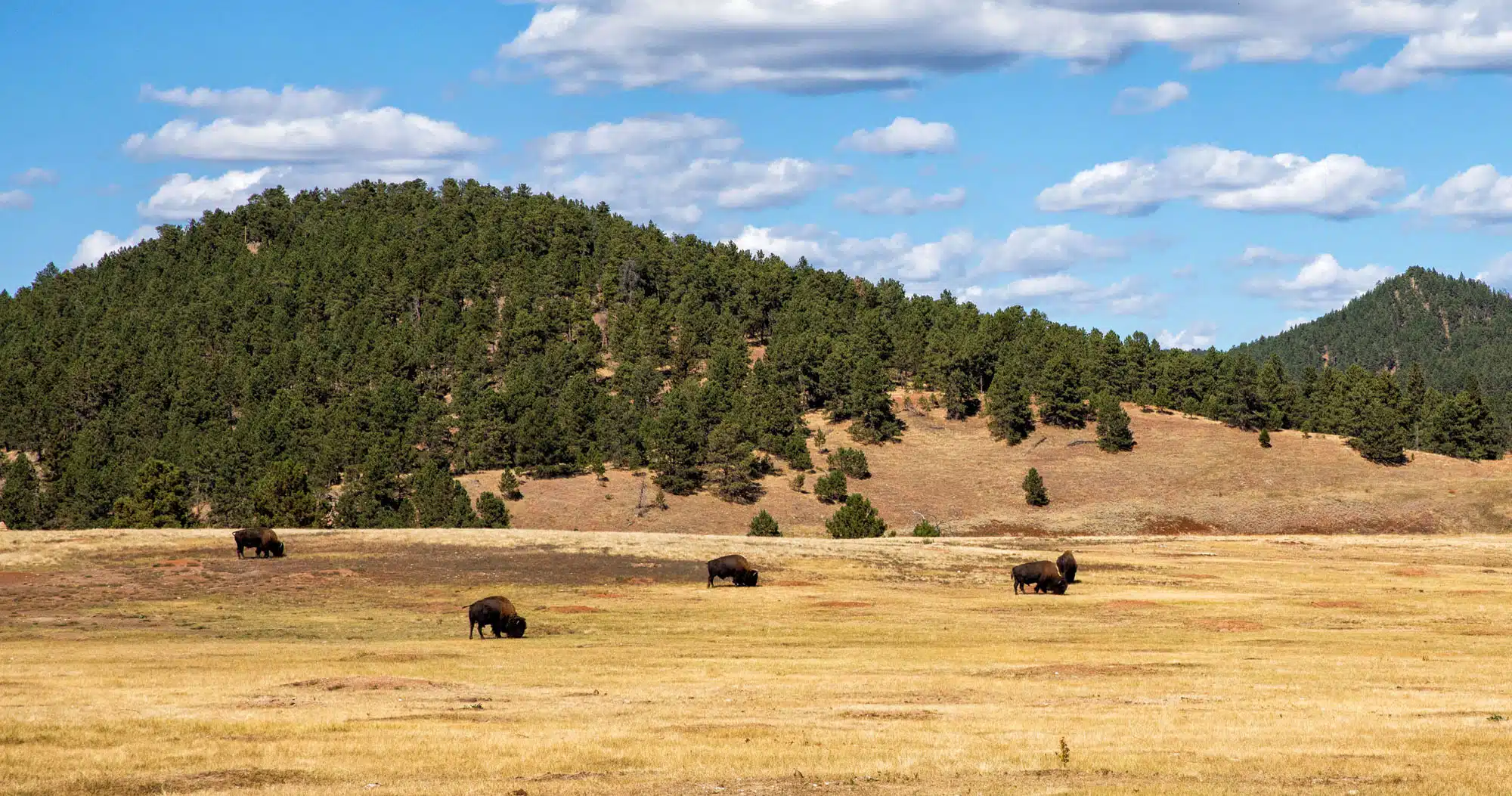





Comments 1